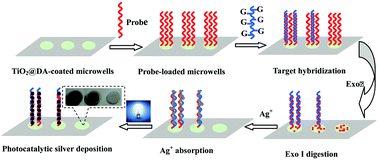Synergic TiO2 photocatalysis and guanine photoreduction for silver deposition amplification: an ultrasensitive and high-throughput visualized colorimetric analysis strategy for anthrax DNAs in blood using a wettable microwells array
Abstract
An ultrasensitive and high-throughput visualized colorimetric method has been initially developed with a wettable microwells array for probing guanine base-containing anthrax DNAs in blood based on silver deposition amplified by the synergic TiO2 photocatalysis and guanine photoreduction under visible light. Hydrophilic microwells were first created on the hydrophobic slides to yield the wettable microwells array, on which photocatalytic titanium dioxide (TiO2) nanoparticles were deposited with dopamine (DA) to yield TiO2@DA for anchoring single strand DNA (ssDNA) capture probes without guanine bases. After the hybridization of the targeted anthrax DNAs, exonuclease I (Exo I) was introduced into the microwells to selectively digest the unhybridized ssDNA probes. The silver deposition was further conducted by the synergic photocatalysis of TiO2@DA and photoreduction of guanine bases of anthrax DNAs, thus achieving the amplified silver signals for the visualized colorimetric assays. Moreover, benefitting from the wettability feature of the hydrophilic–hydrophobic interfaces of the microwells array so fabricated, DNA analytes could be accumulated from the sample droplets through the condensing enrichment process to realize the ultrasensitive detection, in addition to circumventing any crossover contaminants between the sample droplets. The developed visualized colorimetric method with the microwells array was subsequently applied for probing anthrax DNAs in blood with levels down to 1.0 fM. DNAs with single-base and double-base mutations could also be identified accurately. Importantly, such a biosensing design route of a wettable microwells array, in combination with the photocatalytic silver deposition and specific Exo I-catalytic probe digestion, may promise extensive applications for the high-throughput, ultrasensitive, and selective detection of guanine-containing DNA targets with ultra-trace levels in complicated samples like blood.



 Please wait while we load your content...
Please wait while we load your content...